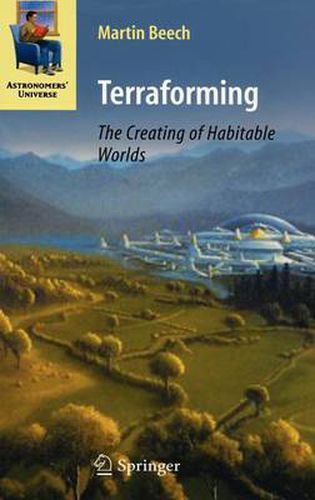Readings Newsletter
Become a Readings Member to make your shopping experience even easier.
Sign in or sign up for free!
You’re not far away from qualifying for FREE standard shipping within Australia
You’ve qualified for FREE standard shipping within Australia
The cart is loading…






The word “terraforming” conjures up many exotic images and p- hapsevenwildemotions,butatitscoreitencapsulatestheideathat worldscanbechangedbydirecthumanaction.Theultimateaimof terraforming is to alter a hostile planetary environment into one that is Earth-like, and eventually upon the surface of the new and vibrant world that you or I could walk freely about and explore. It is not entirely clear that this high goal of terraforming can ever be achieved, however, and consequently throughout much of thisbooktheterraformingideasthatarediscussedwillapplytothe goal of making just some fraction of a world habitable. In other cases,theterraformingdescribedmightbeaimedatmakingaworld habitablenotforhumansbutforsomepotentialfoodsourcethat,of course, could be consumed by humans. The many icy moons that reside within the Solar System, for example, may never be ideal locationsforhumanhabitation,buttheypresentthegreatpotential for conversion into enormous hydroponic food-producing centers. The idea of transforming alien worlds has long been a literary backdrop for science fiction writers, and many a make-believe planet has succumbed to the actions of direct manipulation and the indomitable grinding of colossal machines. Indeed, there is something both liberating and humbling about the notion of tra- forming another world; it is the quintessential eucatastrophy espoused by J. R. R. Tolkien, the catastrophe that ultimately brings about a better world. When oxygen was first copiously produced by cyanobacterial activity on the Earth some three billion years ago, it was an act of extreme chemical pollution and a eucatastrophy. The original life-nurturing atmosphere was (eventually) changed f- ever, but an atmosphere that could support advanced life forms came about.
$9.00 standard shipping within Australia
FREE standard shipping within Australia for orders over $100.00
Express & International shipping calculated at checkout
The word “terraforming” conjures up many exotic images and p- hapsevenwildemotions,butatitscoreitencapsulatestheideathat worldscanbechangedbydirecthumanaction.Theultimateaimof terraforming is to alter a hostile planetary environment into one that is Earth-like, and eventually upon the surface of the new and vibrant world that you or I could walk freely about and explore. It is not entirely clear that this high goal of terraforming can ever be achieved, however, and consequently throughout much of thisbooktheterraformingideasthatarediscussedwillapplytothe goal of making just some fraction of a world habitable. In other cases,theterraformingdescribedmightbeaimedatmakingaworld habitablenotforhumansbutforsomepotentialfoodsourcethat,of course, could be consumed by humans. The many icy moons that reside within the Solar System, for example, may never be ideal locationsforhumanhabitation,buttheypresentthegreatpotential for conversion into enormous hydroponic food-producing centers. The idea of transforming alien worlds has long been a literary backdrop for science fiction writers, and many a make-believe planet has succumbed to the actions of direct manipulation and the indomitable grinding of colossal machines. Indeed, there is something both liberating and humbling about the notion of tra- forming another world; it is the quintessential eucatastrophy espoused by J. R. R. Tolkien, the catastrophe that ultimately brings about a better world. When oxygen was first copiously produced by cyanobacterial activity on the Earth some three billion years ago, it was an act of extreme chemical pollution and a eucatastrophy. The original life-nurturing atmosphere was (eventually) changed f- ever, but an atmosphere that could support advanced life forms came about.